Chapter: 12th Physics : Electrostatics
Electrostatic potential at a point due to an electric dipole
Electrostatic potential at a point due to an
electric dipole
Consider two equal and
opposite charges separated by a small distance 2a as shown in Figure 1.26. The
point P is located at a distance r from the midpoint of the dipole. Let θ be
the angle between the line OP and dipole axis AB.
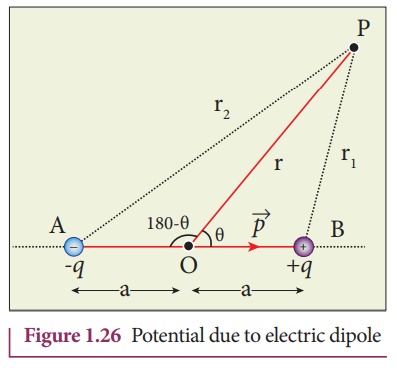
Let r1 be the
distance of point P from +q and r2 be the distance of point P from
–q.
Potential at P due to
charge +q =

Potential at P due to
charge –q=

Total potential at the
point P,

Suppose if the point P
is far away from the dipole, such that r>>a, then equation (1.35) can be
expressed in terms of r.
By the cosine law for
triangle BOP,
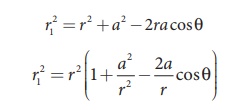
Since the point P is
very far from dipole, then r>>a. As a result the term a2/r2 is very small and can be
neglected. Therefore
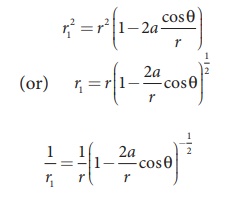
Since a/r <<1 , we can use binomial
theorem and retain the terms up to first order

Similarly applying the
cosine law for triangle AOP,

Using Binomial theorem,
we get

Substituting equation
(1.37) and (1.36) in equation (1.35),
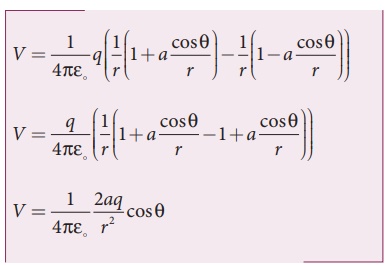
But the electric dipole
moment p = 2qa and we get,

Now we can write p cosθ
= ![]() ×r , where r is the unit vector from the point O to point P.
Hence the electric potential at a point P due to an electric dipole is given by
×r , where r is the unit vector from the point O to point P.
Hence the electric potential at a point P due to an electric dipole is given by

Equation (1.38) is valid
for distances very large compared to the size of the dipole. But for a point
dipole, the equation (1.38) is valid for any distance.
Special cases
Case (i) If the point P lies on
the axial line of the dipole on the side of +q, then θ = 0. Then the
electric potential becomes

Case (ii) If the point P lies on
the axial line of the dipole on the side of –q, then θ = 180o,
then

Case
(iii) If the
point P lies on the equatorial line of the dipole, then θ = 90o.
Hence

Important points
(i) The potential due to an
electric dipole Important points falls as 1/r2 and the
potential due to a single point charge falls as 1/r. Thus the potential due to the dipoler falls
faster than that due to a monopole (point charge). As the distance increases
from electric dipole, the effects of positive and negative charges nullify each
other.
(ii) The potential due
to a point charge is spherically symmetric since it depends only on the
distance r. But the potential due to a dipole is not spherically symmetric
because the potential depends on the angle between ![]() and
position vector
and
position vector ![]() of the point.
of the point.
However the dipole
potential is axially symmetric. If the position vector ![]() is
rotated about
is
rotated about ![]() by keeping θ fixed, then all points on the
cone at the same distance r will have the same potential as shown in Figure
1.27. In this figure, all the points located on the blue curve will have the
same potential.
by keeping θ fixed, then all points on the
cone at the same distance r will have the same potential as shown in Figure
1.27. In this figure, all the points located on the blue curve will have the
same potential.
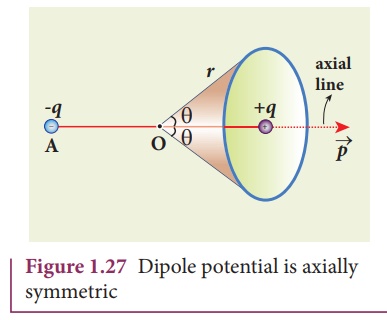
Related Topics